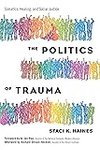
The Politics of Trauma

We need to learn both to trust ourselves and callings deeply, and to educate ourselves to see the social conditioning that may be built into our desires and wants. Whom and what do our longings serve? Whom might they be impacting in a negative way?
Staci Haines • The Politics of Trauma
generative somatics | Diagram designs: Querido Galdo, www.queridomundo.com
Staci Haines • The Politics of Trauma
Over-accountability is taking on blame, responsibility, and fault automatically.
Staci Haines • The Politics of Trauma
Because of inequitable social conditions, particular peoples have been encouraged to imagine, to want, and to declare futures. Others have been systematically discouraged from doing this.
Staci Haines • The Politics of Trauma
Lastly, dissociation asks us to consider Who is leaving, and who is left behind when we dissociate?
Staci Haines • The Politics of Trauma
Sensations are the building blocks of our experiences—meaning, at the base of every internal experience is sensation. Understanding sensations as a foundational language, we can then feel emotions.
Staci Haines • The Politics of Trauma
Pelvic armoring can also show up as the pelvis pushed forward or tilted back.
Staci Haines • The Politics of Trauma
Resilience is a tool for healing and creating just, loving, and sustainable conditions, not one to rationalize violence and oppression.
Staci Haines • The Politics of Trauma
Learning to feel and perceive safety shaping lets us more clearly see what we are working with. Given the embodiment of the shaping, we can know that trying to “fix” it, talk someone out of it, or override it will not work.